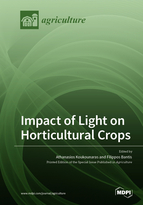Impact of Light on Horticultural Crops
A special issue of Agriculture (ISSN 2077-0472). This special issue belongs to the section "Crop Production".
Deadline for manuscript submissions: closed (20 September 2022) | Viewed by 37740
Special Issue Editors
Interests: cultivation techniques for vegetable production; quality of vegetable products; hydroponic vegetable production; postharvest physiology of vegetables; role of light on vegetables’ growth; quality of seedlings; quality and seed germination; vegetable grafting; innovative forms of vegetable products; organic cultivation of vegetables
Special Issues, Collections and Topics in MDPI journals
Interests: horticulture;plant photobiology;controlled environment agriculture;plant physiology;vegetable grafting
Special Issues, Collections and Topics in MDPI journals
Special Issue Information
Dear Colleagues,
Light is an essential factor for the growth and quality of horticultural plants and its effects depend upon parameters such as duration, intensity and quality. It is an energy source for photosynthesis as well as a signal triggering plant photomorphogenesis and physiological, biochemical and molecular responses. However, solar light strongly differs between winter and summer conditions, with excess light in open field cultivations imposing severe stress on plants, especially during summer months, while supplementary light sources are implemented in greenhouse crop production to complement natural light when it is insufficient. On the other hand, artificial lighting is used as the sole lighting source in plant factories and nurseries (i.e., healing chambers, plant tissue culture). In order to enhance sustainability and profitability, light must be studied and efficiently applied within horticultural crop production. Novel technologies such as light-emitting diodes, new transparent greenhouse covering materials, photoselective nettings, growth chambers and plant factories showcase the critical role of light interacting with plants from the level of seed germination to growth rate, product quality and postharvest storage.
This Special Issue focuses on recent findings in horticultural crops with regard to light characteristics (i.e., quality, quantity etc.) presented as research papers, short communications and review articles.
Dr. Athanasios Koukounaras
Dr. Filippos Bantis
Guest Editors
Manuscript Submission Information
Manuscripts should be submitted online at www.mdpi.com by registering and logging in to this website. Once you are registered, click here to go to the submission form. Manuscripts can be submitted until the deadline. All submissions that pass pre-check are peer-reviewed. Accepted papers will be published continuously in the journal (as soon as accepted) and will be listed together on the special issue website. Research articles, review articles as well as short communications are invited. For planned papers, a title and short abstract (about 100 words) can be sent to the Editorial Office for announcement on this website.
Submitted manuscripts should not have been published previously, nor be under consideration for publication elsewhere (except conference proceedings papers). All manuscripts are thoroughly refereed through a single-blind peer-review process. A guide for authors and other relevant information for submission of manuscripts is available on the Instructions for Authors page. Agriculture is an international peer-reviewed open access monthly journal published by MDPI.
Please visit the Instructions for Authors page before submitting a manuscript. The Article Processing Charge (APC) for publication in this open access journal is 2600 CHF (Swiss Francs). Submitted papers should be well formatted and use good English. Authors may use MDPI's English editing service prior to publication or during author revisions.
Keywords
- Light quantity and quality
- Light-emitting diodes (LEDs)
- Plant factory with artificial lighting (PFAL)
- Physiology
- Photomorphogenesis
- Photosynthesis
- Plant growth and quality
- Postharvest storage
- Climate change
- Shade net house







